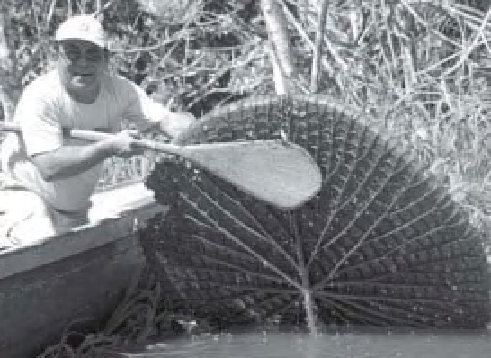Geoscience Reference
In-Depth Information
A
Figure 6-26.
Northern water milfoil (
Myriophyllum
sibiricum
) seen through shallow, clear water at Blue
Lake, near Cuchara, Colorado, United States. Photo by
J.S. Aber and S.W. Aber.
B
Figure 6-25.
Giant waterlily (
Victoria amazonica
).
A. White l ower blooms at night and turns a pale pink
color when pollinated. B. Bottom side is protected with
numerous l esh-piercing spines. The plant is quite
popular in tropical and subtropical water gardens
around the world. Photos from Brazil, courtesy of
K. Buchele.
Figure 6-27.
Common bladderwort (
Utricularia
vulgaris
) seen early in the spring before water surface
becomes covered with vegetation. Photo by J.S. Aber;
Mined Land Wildlife Area, southeastern Kansas, United
States.
vegetation are developed across the transition
from dry, upland positions into deep-water
environments.
In some cases, wetland vegetation zones are
well dei ned and continuous along a shoreline
or around a body of water (Fig. 6-29). In other
cases, an irregular patchwork of vegetation
zones rel ects microtopography of the wetland
environment (Fig. 6-30). Similar transitional
zones mark the change from fresh
-
water to salt-
water chemistry along marine coastlines and
around inland saline lakes and playas (see Color
Plate 2-16).
It should be noted that not all wetland plants
i t easily into this zonation scheme. This is par-
ticularly true of plants that may occupy shore-
lines, wet meadows, stream banks, exposed
mudl ats, and other marginal zones (Larson
2006). As water level l uctuates, these plants
may come into either shoreline or emergent
categories. Some hydrophytes may grow either
as submerged or emergent types, and the emer-
gent morphology may be quite different from
the submerged plant form. Such plants are
called amphibious (Larson 2006). Typical
examples include yellow water-crowfoot








